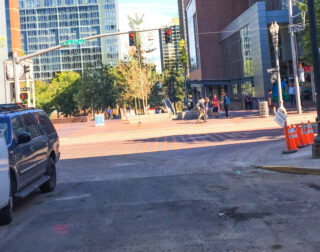
(Photo © Jonathan Maus)
Portlanders are still coming to grips with the traffic violence experienced downtown on Friday. While details about 61-year-old Greg Porter continue to trickle out and the women he hit still recover at an area hospital, leaders in the transportation reform community are moving from grief and shock into action.
Kiel Johnson and Sarah Iannarone (both familiar names to BikePortland readers) are organizing an event next Tuesday (June 5th) that aims to promote an inclusive Portland. Here’s the event description:
“An inclusive city is one that values all people and their needs equally. It is one in which all residents—including the most marginalized of poor workers—have a representative voice in governance, planning, and budgeting processes, and have access to sustainable livelihoods, legal housing and affordable basic services such as water/sanitation and an electricity supply.” — Rhonda Douglas
As we head toward summer, many in our community are filled with hope and joy. For others, this has also been a challenging time, including friends and family of the women injured by vehicular violence at PSU on 5/25 alongside the critical injuries sustained by PSU student Aaron Salazar on 5/15.
For this event, we will reclaim the portion of Montgomery Street between SW 6th and Broadway as an impromptu public plaza for Portlanders– free from hate or violence of any kind. We will gather to share in joy and to support each other in sorrow. We will encourage speakers who are interested in stepping up to the mic to share what an “Inclusive Portland” looks and feels like to them.
Invite your friends, bring your lunch,and join us for an old-fashioned sit-in as we shut down this block of Montgomery Street for this “Inclusive Portland Lunch-In” for a couple of hours.”
Advertisement
https://twitter.com/ReedKATU/status/1001622130692276224
“We believe that every person has the right to access their community by walking – and should not be afraid to do so.”
— Oregon Walks
The location of this event — across the street from where the three women were seriously injured after Porter drove his car into them — is strategic. Just last fall we shared an effort to make the block of SW Montgomery between 6th and Broadway carfree. A new Portland State University building spurred redevelopment of half the blockface and it was a golden opportunity to create a carfree corridor that would have stretched from SW 5th to I-405. Friday’s hit-and-run has reignited talk of banning cars on SW Montgomery.
Johnson and Iannarone hope to create a temporary carfree zone on Tuesday. They’re asking for bicycle users to help cork both ends of the relatively low-traffic street during the event in order to improve the safety of everyone.
On a related note, KATU reporter Reed Andrews posted on Twitter yesterday that PSU will consider adding bollards to better protect the Urban Plaza from errant drivers.
And yesterday, two local groups that work to make walking safer issued statements about the state of walking in Portland.

(Graphic from PedPDX Community Advisory Committee)
The nonprofit Oregon Walks issued a statement on their blog saying, “We believe that every person has the right to access their community by walking – and should not be afraid to do so.” OW pointed out one witness from a news report that said she might take her classes online due to fears of walking. “The fact that a student feels so unsafe walking through a public space that she’s considering avoiding it all together is unacceptable. What does it say about Portland as a community when we can no longer have the reasonable expectation of personal safety when we inhabit our shared spaces?”
The 25-member Community Advisory Committee that’s working on the City of Portland’s PedPDX citywide walking plan issued a statement today honoring eight* people, “who have lost their lives in traffic violence while walking on our Portland streets this year.” “By honoring and acknowledging each person, the CAC wishes to center the gravity of safety and Vision Zero in the PedPDX planning process.”
(*You’ll note that while the City of Portland counts eight walking fatalities so far this year, we only count seven on our official tracker. This is because one of the deaths, 42-year-old Eric Griffen, occurred after he intentionally jumped from an I-5 overpass. By their own policy, PBOT excludes intentional deaths.)
— Jonathan Maus: (503) 706-8804, @jonathan_maus on Twitter and jonathan@bikeportland.org
Never miss a story. Sign-up for the daily BP Headlines email.
BikePortland needs your support.


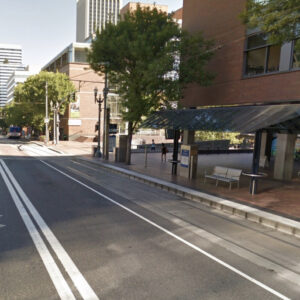
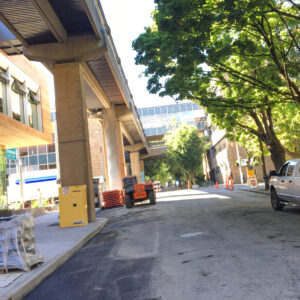
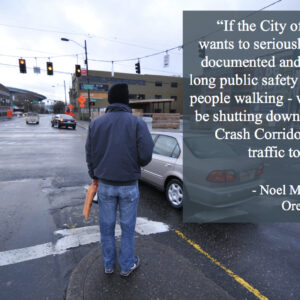
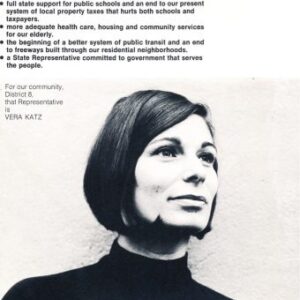
Thanks for reading.
BikePortland has served this community with independent community journalism since 2005. We rely on subscriptions from readers like you to survive. Your financial support is vital in keeping this valuable resource alive and well.
Please subscribe today to strengthen and expand our work.
It’s gonna take more than pious talk from politicians and feel good gatherings to correct Portland’s traffic violence problem.
Sharing those resources and ideas would benefit others in the face of trauma and grief, and I’m sure we’d be grateful to utilize them. People are still feeling beings , and reserve the right to express that. Thankyou to those who offer up additional ways to deal with this issue
Every major city on other continents, that I’ve been to, have carfree zones, either permanent or temporary… It always makes the cities so much more livable.
Not only should the one-block section (between Broadway and 6th Ave) of Montgomery be car free, but so should the streets of College, Hall, Harrison, and Mill!
This is doable.
I would love to see any downtown campus area be walk/bike only (with exceptions for transit and handicapped parking). It’s actually fairly painful to drive down there already. That’s one aspect I very much enjoy about some European cities…the roads are so old and narrow they simply do not allow for autos in certain areas.
Of course, assuming you obeyed the law around where you are permitted to drive while trying to murder people, there will always be places you can find victims. Carless areas can be great, but they don’t address issues like this one.
Very true.
but HK, Urban design fixes EVERYTHING!
How can you turn an act by an acknowledged mentally ill person, and turn it into your political rallying point? His behavior had nothing to do with laws, walking in a city, bollards, or even cars in general. He could have just as easily used a knife or a gun in his rage against humanity.
How is his mental state relevant? The flaw is in the urban space. It shouldn’t be possible for one sicko to run down a crowd of people, just because they are having a bad day.
Are you going to bollard every sidewalk in town?
In the history of humanity, has it EVER been possible to prevent one human from harming another?
Yes- every day, every minute.
Please stop with the strawman. Anderson’s topic was one person running down _a crowd_, not one-on-one.
And I am asking you which urban spaces exist where one human cannot harm several other people at once. If not using a car as a weapon…then another weapon. His question poses something as if it is possible, when it is not.
And I am telling you that is different than what you asked at 9:50 a.m. Acknowledge and apologize for your employment of a strawman fallacy, promise not to do it again, and you might find that serious people take you seriously enough to answer your revised query.
You’re quite amusing.
The absolute horror of limiting use of weapons (or things that can be easily weaponized) in areas where very large numbers of people gather!!!1!
Protected bike lanes in the form of on street parking would’ve provide such a barricade.
Do you like parking protected bike lanes? Personally I don’t like to be corralled into a door zone.
Personally, I don’t care for any protected lanes. The city doesn’t have enough resources to clean them.
Apart from the buffer between the right side car door and the bike lane, it’s the right side car door, so, not used 90% of the time.
perspective.
And when it IS used, it’s by a passenger who isn’t thinking to look in the mirror, or isn’t sitting in a position where they CAN use the mirror, and the cyclist will have no way to stay out of the door zone other than perhaps riding right up against the curb.
Sorry, but “sicko” is not a very nice term for someone with mental illness.
Mental state is entirely relevant. Reasonable, sane people generally follow rules, standards ad protocols…you know, commonly accepted methods of behavior. Mentally ill people do not – which is why what works for sane people doesn’t work for mentally ill people (or those people filled with ill intent).
“His behavior had nothing to do with … cars in general.”
Guns don’t kill people.
Correct on both counts!
Um, so you’re saying rallying would not occur if the attacker had used a knife or a gun? Sounds like some research is in order: http://www.wweek.com/news/2017/05/27/portlanders-arrive-by-the-thousands-for-vigil-to-celebrate-men-who-gave-their-lives-on-max-train/
Hopefully that research consists of more than consulting a single tabloid article referencing a single crime that shocked the entire nation.
People get knifed and shot all the time in Portland and rallies to observe them are rare. How many of the homicides listed here do you recall rallies for https://projects.oregonlive.com/maps/homicides/all/
Oh agreed, that’s just to get him started.
But you seem to imply that it’s somehow not apples-to-apples, even though both the car attack and the knife attack were national news, with multiple victims who shared no previous beef with the attacker. I remain unconvinced. Could you elaborate?
And are you saying that WWeek somehow got it wrong, that no event actually happened after the MAX knife attack last year? Is there anything you can cite to that effect?
This is not apples to apples. The MAX attack involved the murder of a military veteran with 4 kids and a good Samaritan who tried to protect a couple young women from by a violent and overt white supremacist who expressed happiness over the killings.
What I’d suggest is that the response has more to do with who the victims of the crime are than the crime itself.
I seriously doubt this protest would occur if three young black guys got severely injured after being mowed down by a mentally ill homeless man for whom no motive had yet been established.
On that subject, facilities for peds and cyclists in those areas are far inferior to what you’ll find downtown. Traffic speeds are higher as is the harassment factor. But focus continue to remain on those areas that already have it best.
You didn’t specify a location or the racial identity of the attacker in your thought experiment. Assuming the location to still be PSU and the attacker to be of a different race than the victims, the implied racial angle (and so you’re right, it’s all about the context — though not necessarily limited to the “who”) would absolutely bring it extensive media coverage. (See the recent Starbucks coverage, which was about guys getting just kicked out rather than killed.)
Note that the link I pointed to were actual homicides. In the case at hand, the perpetrator did not succeed.
I’m having difficulty recalling rallies for attempted murder that resulted in no one getting killed. For example, I’m hearing no calls for a rally in response to this horrific stabbing which occurred on Tuesday http://www.oregonlive.com/portland/index.ssf/2018/05/portland_stabbing_victim_attac.html
How can you turn an act by an acknowledged driver into your political rallying point? His behavior had nothing to do with being mentally ill. He couldn’t have just as easily been found sane after his rage against humanity.
Agree with Chris Anderson’s point. Your reference of knife and gun is fundamentally flawed because knifes and guns don’t determine the design of our streets and the physical form of our city like cars do and government also doesn’t deliberately design public spaces to make it easy to use knifes and guns. The problem is that many people (and public agencies) willingly ignore the significant safety risk of automobiles because they see faster speed and more unrestricted mobility as a worthy trade-off to human lives.
The fact is that traffic deaths are epidemic (over 40,000 deaths in 2017 in the US), but our policies and designs for urban transportation continue to make driving at high speed easy and convenient. The discussion on creating more car-free zones in downtown is about changing our collective obsession about speed and driving and making a case that we ought to put the public’s safety before private convenience when we decide how to use our streets.
more unrestricted mobility? I never understood this one… cars are the most restrictive forms of transportation… you can’t even leave your designated seat… stuck in traffic? you can’t just go to the side of the road or turn around to find another route because you’re blocked in by a thousand other drivers… need to store your vehicle while you do business? better hope there’s a free parking spot within a half mile of your destination… and don’t forget the time and expense of licensing, registration, insurance, upkeep, and storage…
there’s nothing unrestricted about the little bit of mobility that cars provide…
Unfortunately this mentally ill person is more closely reflecting the driving habits of many “normal” motorists these days than we as a society are comfortable admitting. We developed these open boundaries between dangerous vehicles and pedestrians back when density was lower, pedestrians were fewer and those in need of help had institutions to go to. It is not unreasonable to see this tragedy as a sign we need to rethink this situation.
Wow, nice reach. Most people don’t drive their cars on sidewalks. But plenty of cyclists do downtown. 😉
Sarah typically likes to be on the news when the opportunity affords her to be. There’s plenty of carfree zones, they’re called parks. Portland has plenty of them, including the largest in an urban areaes.
so sad and i’m still in shock how most ppl drive downtown these days, example I had huge road rage against me one day when a guy was trying to run me down on Yamhill near the bricks, I bunny hopped the curb otherwise would have been under his SUV.. I could hear his motor and he was doing about 45 to 50 mph on the MAX tracks trying to catch me in traffic. 🙁
helmet cameras!
oh one more thing I’ve noticed ppl drive wrong way downtown on the max tracks/streets. 🙁
there are so many signs and traffic controls downtown that you need to be going about 10 MPH to ensure you see them all…
they could physically prohibit other vehicles on the MAX areas but they decided it was better to allow the abuse by drivers…
Downtown Portland is built on a design legacy of single occupancy vehicle commuters using it as a thoroughfare and a parking lot. Portland has changed. More people live and spend time downtown. It is long past time for downtown Portland to be redesigned and space reallocated to reflect this change.
remember that the original Portland had plenty of space for people… wide sidewalks everywhere… it wasn’t until the auto industry sunk their teeth in that they started taking away sidewalks and giving them to cars, and then destroying entire swaths of the city for quick selfish freeway mobility out of the city at the cost of the entire city…
Haven’t they already? Trimet only lanes? Better Naito? Bike lanes?
10%
I’m not sure how talking about your feelings is going to prevent lunatics from running people over but keep being you Portland. At least this guy wasn’t Saudi or he’d already be free.
Remember that a young recent candidate for City Council has a DUII for driving down Grand Avenue at double the limit while supposedly acting as “designated driver.” Nevertheless she was endorsed by several prominent political figures, having worked both in offices of Novick and Wheeler.
Probably more than a few BP followers voted for her. After all, she is “a woman of color.”
Dr. King told us, half a century ago, that we ought not “…judge people by the color of their skin, but by the content of their character.” That recent primary was not conducted on content of character. Until voters carefully consider candidates’ character there is little hope.
Even without this incident, many college campuses have streets that are car free, including University of Oregon for one. You don’t need to necessarily point at this incident to advocate for a additional car free streets on a college campus. (I guess there is Park Avenue already?).
Street Trust and Better Block might want to consider proposing to PBOT a trial period of an additional car free street or two on the PSU campus. As to which street that should be, I woudn’t know. They can do some research and outreach and make a recommendation.
With nearly 100% of the streets downtown designed for, and favorable to cars, it would be more than sensible to have at absolute minimum few more blocks for peds and bikes in such a high density area. Nothing against cars personally. I own and drive a truck myself. But it just a simple matter that there is not physical space for the number of people that want to drive on the roads. If hypothetically cars and trucks were bike or motorcycle sized, perhaps traffic wouldn’t be as much of an issue.
I live near the UO. Where, exactly are these car-free streets of which you speak? Students in the ’70’s worked hard to prevent motorists from being able to use E13th as a thoroughfare, but it is NOT closed to private motorists. In fact, there are parking lots and on-street car parking that are only accessible via E13th.
The bollards that once protected campus property north of the railroad tracks have been semi-permanently removed, so we now have cars driving on what appear to any sensible person to be bike paths (and the Knight addition will make it worse as that gets formalized and there are actual parking structures for cars placed along the river).
There’s some recent talk of making the campus’ portion of E15th car-free as part of the expansion of Hayward Field for the world championships, but I’ll believe it when I see it.
The UO has a horrid record with regards to cars and even worse when it comes to bicycle access; they rebuilt the primary entrance from the river to the campus and it’s an unwelcoming disaster. They literally put a huge concrete planter where the bike path was that connects the river to the campus proper.
Oh wait, technically the inside of the buildings is still car-free. However, the way things are going I wouldn’t be surprised to see that change soon.
I thought PSU was already on board for at least a street reduction to replace parking with pedestrian space:
https://www.pdx.edu/campus-planning/sites/www.pdx.edu.campus-planning/files/2009_MontgomeryGreenStreet_Plan%20%281%29.pdf
I am surprised that PSU itself wouldn’t be pushing for more pedestrianized streets in its campus area. I don’t mean streets that are entirely inaccessible to cars and trucks. I mean streets that can be used for deliveries, maintenance vehicles, emergency response but are very inhospitable to routine driving. Europe has plenty of streets like this. They would make the university more attractive to students. Montgomery seems like an excellent place to start.
Such streets, whether in Europe or here, don’t prevent crazy people with cars from deliberately attacking pedestrians. That is such a rare event that I don’t think it merits a complete redesign of our city, which is what you’d have to do, as would be easy enough to drive to another place and run down three different people.
For the couple of such nutters each decade who try to do this, that is. People make the mistake of fixating on a rare and notable tragedy and demanding expenditures far out of proportion to the risk or benefit.